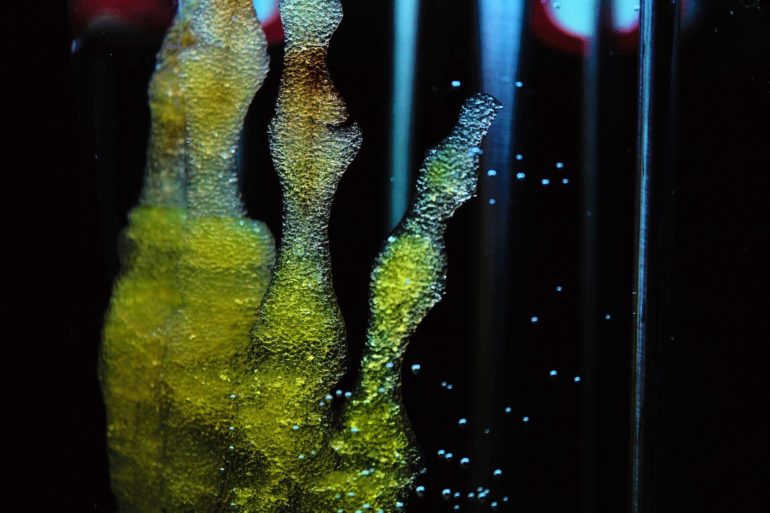Hydrogels are everywhere. They are water-loving polymers that can absorb and retain water, and can be found in such everyday consumer products such as soft contact lenses, disposable diapers, certain foods, and even in agricultural applications. They are also extremely useful in several medical applications due to their high degree of biocompatibility and their ability to eventually degrade and be reabsorbed into the body.
These qualities allow hydrogels to simulate living tissue for tissue replacement or regeneration. One of the most useful of these applications is for healing wounds. Hydrogels are ideal for this purpose, with their ability to hydrate and form a moist and supportive environment. This facilitates processes beneficial for wound healing, such as blood vessel formation, the breakdown of dead tissue, activation of immune cells, the prevention of live cell and tissue death and even the alleviation of pain.
Natural hydrogels, particularly gelatin methacryloyl (GelMA) hydrogels, are favored for wound healing due to their biosafety and exceptional biocompatibility. But their usage is hampered by their inherently poor mechanical properties such as limited stretchiness, relative brittleness and inflexibility, and their inability to adhere to onto tissue surfaces. In order to improve upon these characteristics, variations on preparation methods and components have been attempted.
When a GelMA hydrogel is prepared, a solution of gelatin is made by mixing and dissolving gelatin in water. This results in a dispersion of gelatin polymer chains in the water. A chemical called a photo-initiator is then added to the solution, which makes the polymer chains sticky and allows them to stick to one another. Exposure to UV light activates the photo-initiators and the polymer chains cross-link to each other to form a network. Water molecules enter this network, stretching the chains and becoming locked within them; this illustrates the hydrogels’ absorptive powers and is the point where gelation, or solidification, occurs.
The properties of this gel can be modified by adding chemicals that bind to the polymer chains before UV exposure, or the UV parameters themselves can be varied to tune the gel’s properties. Some of these modifications have been experimented with in previous attempts to improve GelMA’s physical properties.
One approach was to introduce additional chemicals into the GelMA solution before crosslinking; the resultant chemically conjugated hydrogel showed a slight improvement in tissue adhesion. Other attempts have been made at strengthening GelMA by reinforcing flexible thin chemically conjugated GelMA films with additional chemicals. But challenges remain with improving the three mechanical properties of toughness, stretchiness, and adhesive strength simultaneously in GelMA hydrogels.
A collaborative team from the Terasaki Institute for Biomedical Innovation (TIBI) has developed methods for improving all three of these properties in GelMA hydrogels in a simple procedure with tunable fabrication parameters.
The researchers first turned to an example found in nature in their approach to improving adhesion in the hydrogels. Marine mussels secrete strong threads that are used as attachments and pulling ropes on rocks and other irregular surfaces. To form these threads, the mussels produce adhesion proteins in an acidic environment; upon exposure to the slightly alkaline ocean water, the proteins undergo a chemical change which spurs thread formation.
In a corresponding fashion, the TIBI team added large quantities of dopamine, a chemical analog to mussel adhesion protein, to GelMA to increase its strength, stretchiness, and adhesive properties. They also subjected the mixture to alkaline conditions to further increase the GelMA’s adhesive strength.
The results showed that the addition of large quantities of dopamine to the GelMA solution could increase the stretchiness of the resultant hydrogel by almost six-fold and its strength by more than three-fold. Other experiments showed that when the dopamine is subjected to alkaline conditions before the crosslinking step, the adhesive strength could be increased up to four times and its resistance to shear forces by almost seven-fold.
“The experiments we have conducted provide valuable insight into procedures for activating toughness and adhesion in GelMA-based hydrogels,” said Hossein Montazarian, Ph.D., first author of the project.
The researchers will continue to experiment with other chemicals to optimize their effects on GelMA’s mechanical properties. This can lead to improvements in additional applications such as skin-attachable wearable devices or healing and regenerative internal implants.
“The knowledge gained here on the fundamental mechanical properties of hydrogels can have far-reaching effects on biomedical applications,” said Ali Khademhosseini, Ph.D., TIBI’s Director and CEO. “It is one of many examples of impactful research from our biomaterials platform.”
Better, cheaper bio-ink may be used to create artificial organs
More information:
Hossein Montazerian et al, Stretchable and Bioadhesive Gelatin Methacryloyl-Based Hydrogels Enabled by in Situ Dopamine Polymerization, ACS Applied Materials & Interfaces (2021). DOI: 10.1021/acsami.1c10048
Provided by
Terasaki Institute for Biomedical Innovation
Citation:
Marine mussels are a model for improving strength, stretchiness and adhesion in hydrogels for wound healing (2021, August 30)
retrieved 30 August 2021
from https://phys.org/news/2021-08-marine-mussels-strength-stretchiness-adhesion.html
This document is subject to copyright. Apart from any fair dealing for the purpose of private study or research, no
part may be reproduced without the written permission. The content is provided for information purposes only.



